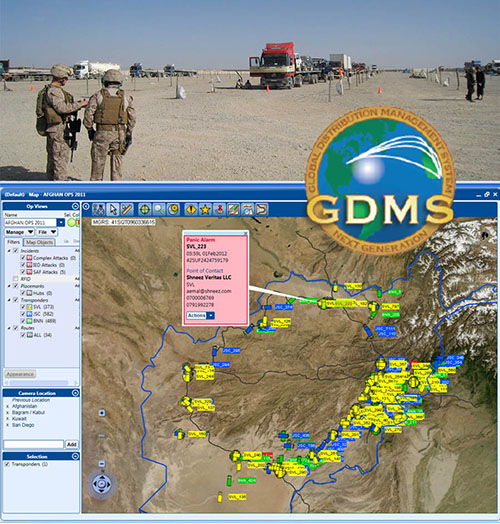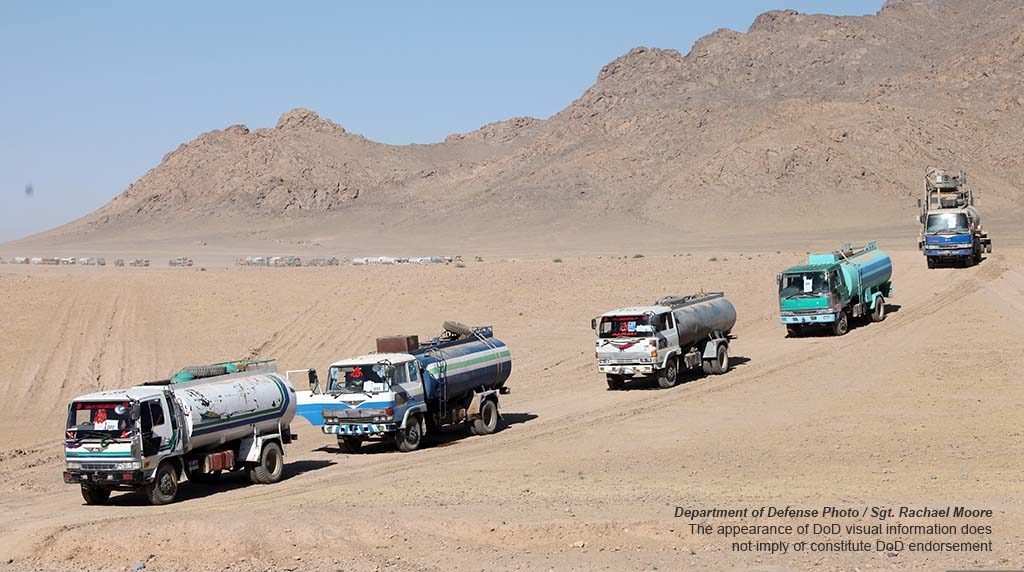SAN DIEGO, April 13, 2017 – For nearly a decade, the U.S. Army has relied on Tapestry Solutions’ Global Distribution Management System (GDMS) to track and manage civilian contractors who transport equipment, fuel, medical supplies and other cargo throughout Afghanistan. The map-centric software tracks the vehicles in near real-time as they pass hazards and checkpoints – providing emergency/panic warnings to support contractor personnel in life-threatening situations.

Vehicle movements are monitored round-the-clock in Tapestry’s Tactical Operations Center.
Today, the GDMS program is stronger than ever, thanks to Tapestry’s dedicated GDMS team. The team received customer recognition for its excellent service, earning Tapestry another 5-year contract to support ground transportation In-Transit Visibility (ITV) in Afghanistan.
The contract award followed a software upgrade involving a new naming convention for the program’s Transportation Movement Requests (TMR). Although the initial requirements appeared to be simple, the underlying code changes actually turned out to be quite complex.
“By acquiring an intimate knowledge of our customer’s requirements, the team was able to deliver a tailored solution on time and within budget,” Michael Spencer, Vice President, Global Sales & Marketing, Tapestry Solutions.
“Our customer-first commitment has been key to the program’s success since its beginnings,” he continued, “and we are very proud to offer a solution that addresses the challenges of managing commercial trucking in a deployed environment.”

GDMS provides panic alerting for units under attack.
GDMS LOGISTICS SUPPORT IN AFGHANISTAN
Tapestry has supported the U.S. military’s logistics operations in Afghanistan since 2009. At the time, the U.S. military’s Host Nation Trucking (HNT) program had gained momentum and attracted slews of in-country drivers.
U.S. Army officials were tasked with managing thousands of civilian cargo shipments per month with manual spreadsheets and limited resources. As a result, trucks and cargo were frequently sent to incorrect locations in war zones and reports were inaccurate. It was extremely difficult to track deliveries, verify demurrage claims and manage contractor performance.
The military asked Tapestry to help find a solution. The San Diego-based company leveraged its GDMS system that was first used in Iraq in 2003 to help U.S. commanders distinguish between civilian and enemy truck movements. Tapestry also provided an alert capability to allow units under enemy attack to notify quick reaction forces (QRF).
In Afghanistan, Tapestry’s GDMS team expanded the program’s functionalities to provide the control, ownership and accountability that the military needed to effectively manage its operations. Within seven months and three software releases later, the GDMS-Mission Tracker was fully operational in Afghanistan.
Today, GDMS successfully manages between 7,000 to 12,000 missions per month in support of HNT and National Afghan Trucking (NAT) registered carriers.
HOW IT WORKS
GDMS acts as a central data-fusion system and gateway, enabling the U.S. military to have near real-time visibility, tracking metrics and accountability on all registered commercial logistics. The system features graphical displays of mission data, including vehicle locations on topographical maps with the capability of providing very accurate location data.

Tapestry technician installs satellite transponder inside vehicle.
At the heart of GDMS is a centralized database that links cargo movements with vehicle-based transponders. The GPS transponders send signals to commercial satellites, which are relayed to a ground station and then sent to Tapestry’s Tactical Operations Center in San Diego, Calif.
From there, the data is sent back to the military customer to provide a near real-time view of truck movements throughout the region. As an incident analytics tool, GDMS is used by intelligence personnel to analyze attacks on tracked vehicles and includes an instant playback feature allowing for course-of-action analysis.
Although GDMS’s primary role is to provide real-time, in-transit visibility of vehicles and cargo shipment, it is much more than a truck tracking system. GDMS is used to manage transportation movement requests, capture actual delivery times, correlate actuals to scheduled requirements, validate demurrage charges, finalize shipments and support invoicing.
GDMS integrates with the TMR systems to provide information needed for cost containment. It can calculate pricing based on shipment type, additional requirements and distance. GDMS’s replay functionality is used for insurance claims, investigations and litigation.
With these features and more, GDMS has saved the U.S. military millions of dollars. With GDMS, military customers can effectively manage the NAT program with less manpower, and above all, help ensure mission accomplishment.

The appearance of U.S. Department of Defense (DoD) visual information
does not imply or constitute DoD endorsement.
Contact:
Janet Dayton
Tapestry Solutions Inc.
tapestrymarketing@boeing.com